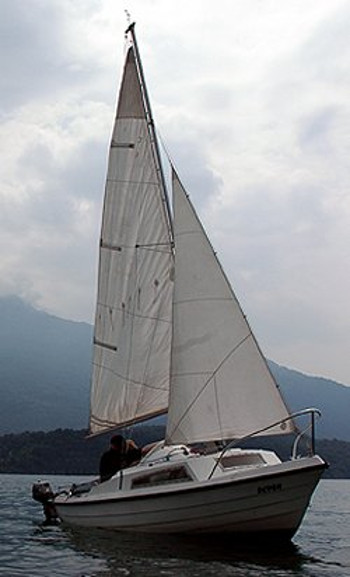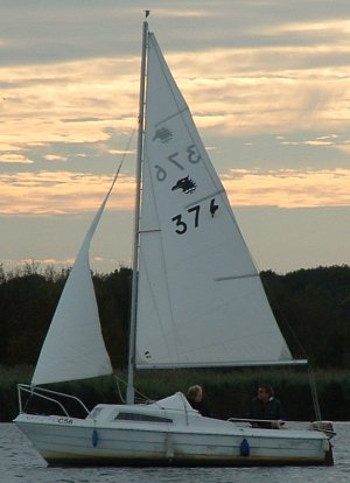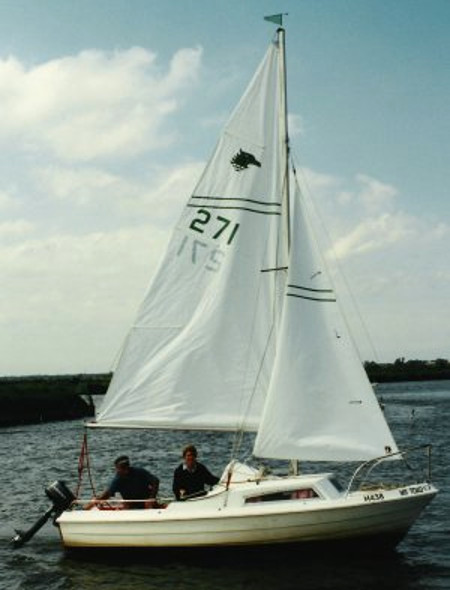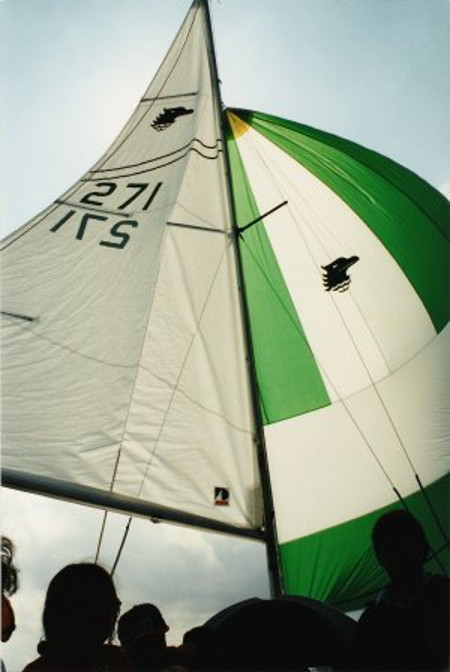Page updated: 9 November 2011
This page offers some comments on the rigs seen of different SeaHawks. More than most on this site, this section demonstrates the ignorance of the web master! Please help by correcting or adding to the information about SeaHawk sails. Offer comments by registering and posting on the SeaHawk Forum.


SeaHawk #267 is seen here with what are believed to be the original Jeckells Main and Jib supplied with the boat in 1973. Apart from the difference in colour with SeaHawk #123, the most obvious difference is that the foot of the jib on #123 is carried much higher than that of #267.
A jib set higher on the forestay by using longer a strop, does allow better visibility under the sail. It also increases the heeling moment. The overall effect is not large with short strop but those who prefer a longer strop also suggest that owners of other boats that have a pulpit prefer the jib set a little higher to reduce wear on the sail.
It would appear that the main on #123 is a replacement from the original. It includes reefing points and the foot has a particular arrangement of panels in the cloth. It can be seen that Jeckells have not stuck to a single design in making up SeaHawk sails.

The apparently un-numbered SeaHawk (actually #263) is a Dutch boat that appears to have sails sourced locally. Its reefing points are set far higher than the earlier boat, #123. Apart from the obvious additional reduction in sail area that the Dutch boat can achieve, are there other benefits? Is it "a reef too far" or does the choice depend on whether the boat is primarily used on coastal on inland waters?
I once assumed that the arrangement of panels in the sail cloth was part if the sail design, but now understand that sail makers buy their cloth from a variety of sources, and it can come in a variety of widths and this is the most important factor in any difference in the shape and angle of the panels of a plain fabric sail, as distinct from the highly patterned spinnakers that you see on some boats. Logically, fewer panels mean a less expensive sail (less waste and less cutting and stitching).
Note the angle of the lowest of the three battens in the mainsail. These all appear to dip on earlier sails, normally following the line of the seam in the sail cloth. On more recent craft the lowest batten appears to run parallel with the boom, rather than the seam. This pattern suggests that the sail was designed for roller reefing, as being parallel allows the sail to be reefed without removing the batten. The angle of the batten matters less in a slab reefed sail as it is easier to bunch it up. It's unclear why this change is seen as the earliest sail plan drawings from John Bennett all seem to show a horizontal lowest batten.


SeaHawks #376 and #406, both appear to have similar main sails, which are different to all those shown above. They have the horizontal lower batten and the two lowest panels in the sail are shaped differently to the earlier examples.
SeaHawk #376 is shown with the standard jib. SeaHawk #406 has a furling head sail. Although the pictures of #406 does not demonstrate it well, it is noticeable that when heavily furled, the nature of the shape of the sail means that it "climbs" the forestay producing a foresail similar to that on #123. Additionally, those using a furling head sail tend to rig the sheets outside the shrouds. Most furling head sails extend aft of the shrouds when full sized, so this is necessary. However, when furled by only a small amount, it then is possible to rig as for a conventional jib and get the sail much closer hauled, which surely must offer a significant advantage?
Many owners consider this jib to be the preferred sail for sailing the Norfolk Broads and other confined spaces where tacking is frequent. It passes easily round the mast and using the forward fairlead on the cabin roof means the sail sets well for close hauled work. In comparison, the full genoa can be cumbersome to tack. The furling genoa is, of course, more adaptable than a fixed headsail but cannot work optimally at all degrees of furling.

Simon Hole kept SeaHawk #271 at Oby Dyke, off the River Bure. Having bought the boat in 1993, in 1995 he ordered new sails. He ordered a main, a larger than standard jib and a "cruising chute".
In the picture, the main is noticeable in having the horizontal lower batten. Not visible in this picture, but clear from another that Simon sent me, is the fact that this sail is constructed from fabric panels of twice the width of any other that I have seen, and the lower batten pocket actually crosses the line of one of these seams. (Is this something which, ideally, should be avoided?) The lowest panel ends up being smaller than those on #376 and #406, but still tapering towards the tack.
The fully extended jib is hoisted on furling gear. The minimal distance both from the tack point and mast, suggests the sail does indeed have a longer luff than the standard jib, but is still considerably smaller than the conventional furling headsail and is rigged inside the shrouds.
The jib also is fitted with tell-tales. Chris Jeckells has written enthusiastically about these in a magazine article as an aid to efficient sail setting. SeaHawk owner Hugh Illingworth says, "They work well, are actually useful to gauge the best angle of sailing when beating, and apart from fun they have instructional value when teaching a youngster - so to be recommended!" Another owner, John Southey, says simply, "I strongly recommend them as a very useful guide to good sail trimming." while others have said, "They are pretty useless in the tree-lined rivers and lakes of the Broads. A tell-tale at the bottom of the sail will tell you one thing and that at the top another, and half a length later the position will be reversed, with out you altering a thing. They only make sense on open water".


Jeckells designed the cruising chute from scratch. Simon has not seen another one on a SeaHawk. All Jeckells had to go on were the dimensions of the mast and forestay. A cruising chute halyard is fixed just below the forestay and the foot is fixed to the bow. This means it acts in the same way as a genoa, though is of lighter material and much fuller. "Compared to a spinnaker this is much more practical for the Broads", claims Simon.
Simon points out that a spinnaker is hoisted up outside the rigging and billows out in front of the boat. The halyard point is above that of the forestay and there is no fixed point on the bottom, just a sheet on both sides and a spinnaker pole on one side. "They are not too practical for the rivers," says Simon, "as when you gybe, the spinnaker pole has to gybe as well, which is not so easy." With the cruising chute, on the other hand, the sail has to "deflate". When it crosses sides it needs to fill the opposite way round. This can be seen in the second view from the cockpit, where you notice that the SeaHawk symbol remains pointing away from the forestay.

